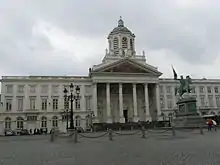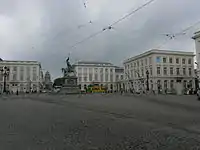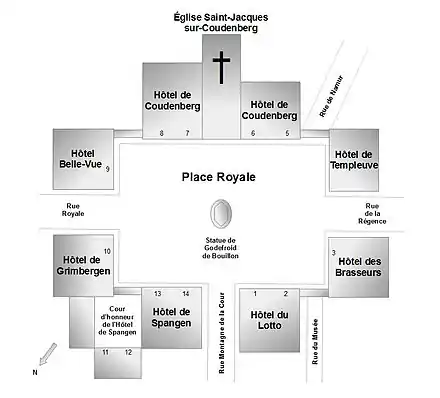Place Royale, Brussels
The Place Royale (French; "Royal Square") or Koningsplein (Dutch; "King's Square") is a historic neoclassical square in the Royal Quarter of Brussels, Belgium. Built between 1775 and 1782 as part of an urban project including Brussels' Park, it is rectangular and symmetrical in shape and is flanked by some of the main museums in the city.
 | |
 Location within Brussels | |
| Length | 113 m (371 ft) |
|---|---|
| Width | 77 m (253 ft) |
| Location | City of Brussels, Brussels-Capital Region, Belgium |
| Quarter | Royal Quarter |
| Coordinates | 50°50′32″N 04°21′34″E |
| Construction | |
| Completion | c. 1780 |
Rue de Namur/Naamsestraat enters the square from the south, Rue de la Régence/Regentschapstraat from the southwest, and Rue Montagne de la Cour/Hofbergstraat and the Mont des Arts/Kunstberg from the northwest. It is served by Brussels Central Station, as well as by the metro stations Parc/Park and Trône/Troon.
History
%252C_Brussels%252C_Belgium_(ca._1890-1900).jpg.webp)
The Place Royale itself is built on the former site of Bailles Square (French: Place des Bailles, Dutch: Dutch: Baliënplein), the main market square adjacent to the former Palace of Coudenberg, which had served as the seat of power of the Dukes of Brabant. The palace burned down on the night of 3 February 1731 in a fire that took much of the original royal complex. Funds were not available for rebuilding, so for more than 40 years, the ruins of the palace remained. It was only in 1774 that Charles Alexander of Lorraine, Governor of the Austrian Netherlands, proposed replacing the ruins with a Royal Square.
Construction of the new buildings around the square took from 1773 to 1780, using the design of French architect Barnabé Guimard, who received that commission in 1769. The square is almost an exact replica of the Place Royale in Reims (France).[1] The first draft of the project, designed by Louis-Joseph Baudour and Claude Fisco, planned to keep the Gothic chapel of the former palace, which had been spared by the fire. Due to the architectural clash with the surrounding neoclassical buildings, however, it was pulled down.
During the Belgian Revolution in 1830, a barricade was erected across the eastern exit of the square next to the current BELvue Museum, facing Brussels' Park.[2] Two cannon were also positioned on it. On 21 July 1831, King Leopold I took the oath as the first King of the Belgians before members of Congress on a platform in front of the Church of St. James on Coudenberg. The funerals of King Leopold III and Prince Charles, prince-regent between 1944 and 1950, also took place on the square.
In 2014, the heritage organisation Beliris announced plans to restore the square's buildings and atmosphere. Final plans will be provided in 2016 and work may begin in 2017.[3]
Layout


The principal building on the Place Royale is the Church of St. James on Coudenberg, consecrated in 1787, and designed by Barré and Guimard. Adjacent to the Church at number 7 is situated the Constitutional Court of Belgium in the Hôtel de Coudenberg.
On the western side of the square is the main building of the Royal Museums of Fine Arts of Belgium, next to the Magritte Museum[4] while on the south-eastern side is the BELvue Museum.[5]
At the centre of the square is an equestrian statue of Godfrey of Bouillon, the leader of the first crusade in 1096. It was sculpted by Eugène Simonis in 1848 to replace the statue of Prince Charles Alexander of Lorraine that had been melted down for the metal during the French Revolution.

See also
External links
| Wikimedia Commons has media related to Place Royale/Koningsplein. |
References
- Fletcher, B: Sir Banister Fletcher's a History of Architecture, p. 821. Architectural Press (1996)
- "L'attaque du Parc de Bruxelles par les Volontaires en 1830". B1830.be. Archived from the original on 23 August 2011. Retrieved 12 April 2013.
- Laporte, Christian (23 November 2014). "Une place encore plus… royale". La Libre Belgique. Retrieved 24 November 2014.
- "Home – Magritte Museum". www.musee-magritte-museum.be. Retrieved 2019-08-15.
- "Museum about Belgium and its history and centre for democracy | BELvue". belvue.be. Retrieved 2019-08-15.